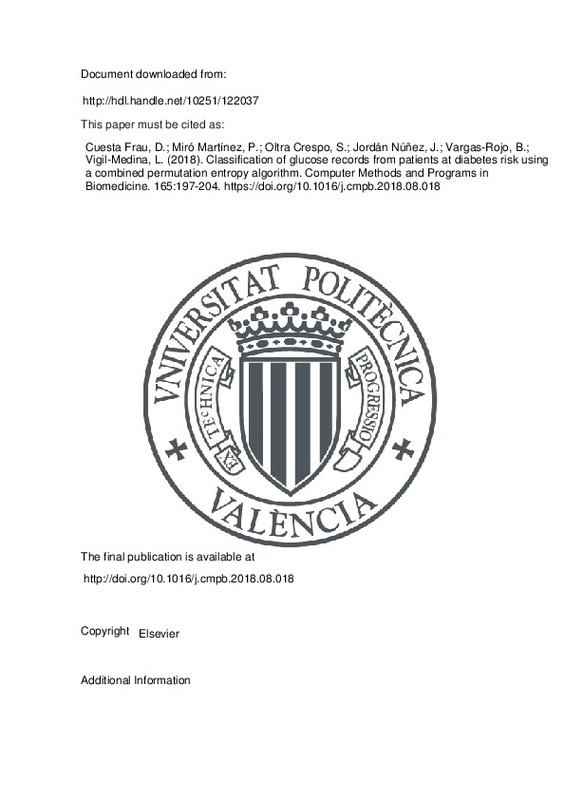JavaScript is disabled for your browser. Some features of this site may not work without it.
Buscar en RiuNet
Listar
Mi cuenta
Estadísticas
Ayuda RiuNet
Admin. UPV
Classification of glucose records from patients at diabetes risk using a combined permutation entropy algorithm
Mostrar el registro sencillo del ítem
Ficheros en el ítem
| dc.contributor.author | Cuesta Frau, David
|
es_ES |
| dc.contributor.author | Miró Martínez, Pau
|
es_ES |
| dc.contributor.author | Oltra Crespo, Sandra
|
es_ES |
| dc.contributor.author | Jordán Núñez, Jorge
|
es_ES |
| dc.contributor.author | Vargas-Rojo, B.
|
es_ES |
| dc.contributor.author | Vigil-Medina, Luis
|
es_ES |
| dc.date.accessioned | 2019-06-12T20:42:08Z | |
| dc.date.available | 2019-06-12T20:42:08Z | |
| dc.date.issued | 2018 | es_ES |
| dc.identifier.issn | 0169-2607 | es_ES |
| dc.identifier.uri | http://hdl.handle.net/10251/122037 | |
| dc.description.abstract | [EN] Background and objectives : The adoption in clinical practice of electronic portable blood or interstitial glucose monitors has enabled the collection, storage, and sharing of massive amounts of glucose level readings. This availability of data opened the door to the application of a multitude of mathematical methods to extract clinical information not discernible with conventional visual inspection. The objective of this study is to assess the capability of Permutation Entropy (PE) to find differences between glucose records of healthy and potentially diabetic subjects. Methods : PE is a mathematical method based on the relative frequency analysis of ordinal patterns in time series that has gained a lot of attention in the last years due to its simplicity, robustness, and per- formance. We study in this paper the applicability of this method to glucose records of subjects at risk of diabetes in order to assess the predictability value of this metric in this context. Results : PE, along with some of its derivatives, was able to find significant differences between diabetic and non¿diabetic patients from records acquired up to 3 years before the diagnosis. The quantitative results for PE were 3.5878 ±0.3916 for the nondiabetic class, and 3.1564 ±0.4166 for the diabetic class. With a classification accuracy higher than 70%, and by means of a Cox regression model, PE demonstrated that it is a very promising candidate as a risk stratification tool for continuous glucose monitoring. Conclusion : PE can be considered as a prospective tool for the early diagnosis of the glucoregulatory system. | es_ES |
| dc.language | Inglés | es_ES |
| dc.publisher | Elsevier | es_ES |
| dc.relation.ispartof | Computer Methods and Programs in Biomedicine | es_ES |
| dc.rights | Reconocimiento - No comercial - Sin obra derivada (by-nc-nd) | es_ES |
| dc.subject | Permutation entropy | es_ES |
| dc.subject | Continuous glucose monitoring | es_ES |
| dc.subject | Signal classification | es_ES |
| dc.subject | Diabetes | es_ES |
| dc.subject.classification | ESTADISTICA E INVESTIGACION OPERATIVA | es_ES |
| dc.subject.classification | ARQUITECTURA Y TECNOLOGIA DE COMPUTADORES | es_ES |
| dc.subject.classification | MATEMATICA APLICADA | es_ES |
| dc.title | Classification of glucose records from patients at diabetes risk using a combined permutation entropy algorithm | es_ES |
| dc.type | Artículo | es_ES |
| dc.identifier.doi | 10.1016/j.cmpb.2018.08.018 | es_ES |
| dc.rights.accessRights | Abierto | es_ES |
| dc.date.embargoEndDate | 2019-10-01 | es_ES |
| dc.contributor.affiliation | Universitat Politècnica de València. Departamento de Matemática Aplicada - Departament de Matemàtica Aplicada | es_ES |
| dc.contributor.affiliation | Universitat Politècnica de València. Departamento de Informática de Sistemas y Computadores - Departament d'Informàtica de Sistemes i Computadors | es_ES |
| dc.contributor.affiliation | Universitat Politècnica de València. Departamento de Estadística e Investigación Operativa Aplicadas y Calidad - Departament d'Estadística i Investigació Operativa Aplicades i Qualitat | es_ES |
| dc.description.bibliographicCitation | Cuesta Frau, D.; Miró Martínez, P.; Oltra Crespo, S.; Jordán Núñez, J.; Vargas-Rojo, B.; Vigil-Medina, L. (2018). Classification of glucose records from patients at diabetes risk using a combined permutation entropy algorithm. Computer Methods and Programs in Biomedicine. 165:197-204. https://doi.org/10.1016/j.cmpb.2018.08.018 | es_ES |
| dc.description.accrualMethod | S | es_ES |
| dc.relation.publisherversion | http://doi.org/10.1016/j.cmpb.2018.08.018 | es_ES |
| dc.description.upvformatpinicio | 197 | es_ES |
| dc.description.upvformatpfin | 204 | es_ES |
| dc.type.version | info:eu-repo/semantics/publishedVersion | es_ES |
| dc.description.volume | 165 | es_ES |
| dc.identifier.pmid | 30337074 | |
| dc.relation.pasarela | S\371846 | es_ES |







![[Cerrado]](/themes/UPV/images/candado.png)

